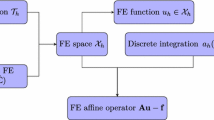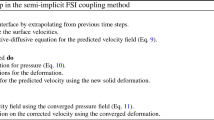Abstract
Multiphysics simulations are playing an increasingly important role in computational science and engineering for applications ranging from aircraft design to medical treatments. These simulations require integration of techniques and tools from multiple disciplines, and in turn demand new advanced technologies to integrate independently developed physics solvers effectively. In this paper, we describe some numerical, geometrical, and system software components required by such integration, with a concrete case study of detailed, three-dimensional, parallel rocket simulations involving system-level interactions among fluid, solid, and combustion, as well as subsystem-level interactions. We package these components into a software framework that provides common-refinement based methods for transferring data between potentially non-matching meshes, novel and robust face-offsetting methods for tracking Lagrangian surface meshes, as well as integrated support for parallel mesh optimization, remeshing, algebraic manipulations, performance monitoring, and high-level data management and I/O. From these general, reusable framework components we construct domain-specific building blocks to facilitate integration of parallel, multiphysics simulations from high-level specifications that are easy to read and can also be visualized graphically. These reusable building blocks are integrated with independently developed physics codes to perform various multiphysics simulations.




















Similar content being viewed by others
References
Allen G, Dramlitsch T, Foster I, Karonis N, Ripeanu M, Seidel E, Toonen B (2001) Supporting efficient execution in heterogeneous distributed computing environments with Cactus and Globus. In: Proceedings of Supercomputing ’01 (CDROM), Denver, CO
Allan B, Armstrong R, Wolfe A, Ray J, Bernholdt D (2002) The CCA core specification in a distributed memory spmd framework. Concurr Comput Pract Exp 5:323–345
Budge KG, Peery JS (1998), Experiences developing ALEGRA: a C++ coupled physics framework. In: Workshop on Object Oriented Methods for Interoperable Scientific and Engineering Computing
Bassetti F, Brown D, Davis K, Henshaw W, Quinlan D (1998) Overture: an object-oriented framework for high performance scientific computing. In: Proceedings of Supercomputing ’98 (CDROM), San Jose, CA
Reynders JVW et al (1996) POOMA: a framework for scientific simulations on parallel architectures. In: Wilson GV, Lu P (eds) Parallel programming using C++, MIT, pp 553–594
Stewart JR, Edwards HC (2004) A framework approach for developing parallel adaptive multiphysics applications. Finite Elem Anal Des 40:1599–1617
Liskov B, Castro M, Shrira L, Adya A (1999) Providing persistent objects in distributed systems. Lect Notes Comput Sci 1628:230–257
Hakonen H, Leppanen V, Raita T, Salakoski T, Teuhola J (1999) Improving object integrity and preventing side effects via deeply immutable references. In: Proceedings of Sixth Fenno-Ugric Symposium on Software Technology, FUSST’99, pp 139–150
Stevens P, Pooley R (1999) Using UML: software engineering with objects and components. Addison-Wesley
London K, Dongarra J, Moore S, Mucci P, Seymour K, Spencer T (2001) End-user tools for application performance analysis using hardware counters. In: International Conference on Parallel and Distributed Computing Systems
Huang C, Lawlor O, Kalé LV (2003) Adaptive MPI. In: Proceedings of the 16th International Workshop on Languages and Compilers for Parallel Computing (LCPC 03), College Station, TX
Huang C, Zheng G, Kumar S, Kalé LV (2006) Performance evaluation of adaptive MPI. In: Proceedings of ACM SIGPLAN Symposium on Principles and Practice of Parallel Programming 2006
Kalé LV (2002) The virtualization model of parallel programming: runtime optimizations and the state of art. In: Los Alamos Computer Science Institute (LACSI) 2002, Albuquerque, NM
Zheng G (2005) Achieving high performance on extremely large parallel machines. PhD Thesis, Department of Computer Science, University of Illinois at Urbana-Champaign
Kale LV, Zheng G, Lee CW, Kumar S (2006) Scaling applications to massively parallel machines using projections performance analysis tool. In: Future generation computer systems special issue on: large-scale system performance modeling and analysis, vol. 22:347–358
Kalé LV (2004) Performance and productivity in parallel programming via processor virtualization. In: Proceedings of the 1st International Workshop on Productivity and Performance in High-End Computing (at HPCA 10), Madrid, Spain
Zheng G, Lawlor OS, Kalé LV (2006) Multiple flows of control in migratable parallel programs. In: Proceedings of the 8th Workshop on High Performance Scientific and Engineering Computing (HPSEC-06), Columbus, Ohio
Jiao X, Heath MT (2004) Overlaying surface meshes, part I: algorithms. Int J Comput Geom Appl 14:379–402
Jiao X, Heath MT (2004) Overlaying surface meshes, part II: topology preservation and feature detection. Int J Comput Geom Appl 14:403–419
Farhat C, Lesoinne M, LeTallec P (2004) Load and motion transfer algorithms for fluid/structure interaction problems with non-matching discrete interfaces: momentum and energy conservation, optimal discretization and application to aeroelasticity. Comput Meth Appl Mech Eng 157:95–114
Bernardi C, Maday Y, Patera AT (1994) A new nonconforming approach to domain decomposition: the mortar element method, In: Brezis H, Lions JL (eds) Nonlinear PDEs and Their Applications, Collège de France Seminar, vol XI, pp 13–51
Belgacem FB, Maday Y (1997) The mortar element method for three dimensional finite elements. RAIRO Math Model Numer Anal 31:289–302
Jiao X, Heath MT (2004) Common-refinement based data transfer between nonmatching meshes in multiphysics simulations. Int J Numer Meth Eng 61:2401–2427
Jaiman RK, Jiao X, Geubelle PH, Loth E (2005) Assessment of conservative load transfer for fluid-solid interface with non-matching meshes. Int J Numer Meth Eng 64:2014–2038
Osher S, Fedkiw R (2003) Level set methods and dynamic implicit surfaces. Springer, Berlin Heidelberg New York
Sethian JA (1999) Level set methods and fast marching methods. Cambridge University Press, Cambridge
Thompson JF, Soni BK, Weatherill NP (eds) (1999) Handbook of grid generation. CRC Press, Boca Raton
Freitag L, Leurent T, Knupp P, Melander D (2002) MESQUITE design: issues in the development of a mesh quality improvement toolkit. In: 8th Int. Conf. Numer. Grid Gener. Comput. Field Sim., pp 159–168
Lawlor OS, Kalé LV (2002) A voxel-based parallel collision detection algorithm. In: Proceedings of International Conference Supercomputing, pp 285–293
Wilson WG, Anderson JM, Vander Meyden M (1992) Titan IV SRMU PQM-1 overview. AIAA Paper 92-3819
Acknowledgments
We thank many of our colleagues at CSAR, especially Damrong Guoy, Xiaosong Ma (now at NCSU), and Soumyadeb Mitra for their contributions to Roccom and service utilities, and Prof. Philippe Geubelle, Drs. Robert Fiedler, Luca Massa, Ali Namazifard, and Bono Wasistho for their input on the Rocman orchestration framework. The CSAR research program is supported by the U.S. Department of Energy through the University of California under subcontract B523819.
Author information
Authors and Affiliations
Corresponding author
Rights and permissions
About this article
Cite this article
Jiao, X., Zheng, G., Alexander, P.A. et al. A system integration framework for coupled multiphysics simulations. Engineering with Computers 22, 293–309 (2006). https://doi.org/10.1007/s00366-006-0034-x
Received:
Accepted:
Published:
Issue Date:
DOI: https://doi.org/10.1007/s00366-006-0034-x




